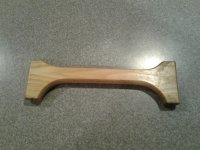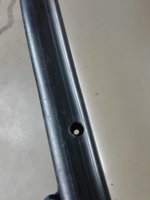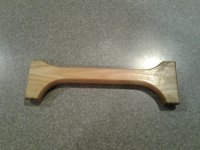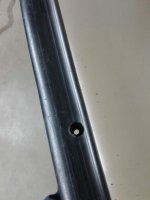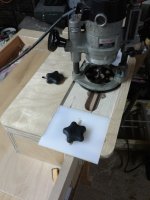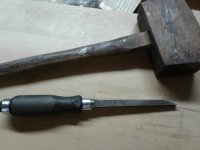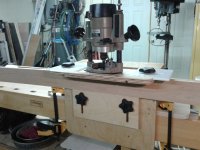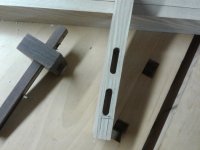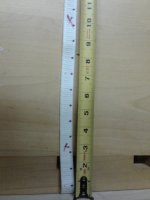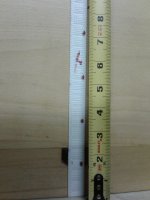I bought a Royalex Dagger Reflection 15 back in the winter and after cleaning it up, refinishing the woodwork, adding new seat webbing and stainless steel hardware and using a lot of heat and sweat to remove some hogging a young couple we know who were just beginning to paddle together bought it. Soo...
Two weeks ago another three seat Reflection 15 popped up on Craigslist less than two hours away. It is sun faded Midnight Blue, has only a few small dings and shallow scratches and I only paid $150 for it. As I noted in a thread about removing pine sap (denatured alcohol was the best thing I found for dried on sap....) it needed the woodwork refinished and seats re-done. Yesterday we had a magnitude 5.1 earthquake nearby enliven the morning and later on I pulled the handles, thwart and seats. I was planning to trim the rotted cane away, refinish the woodwork, flip the seat frames and add webbing to them but the undersides were badly chewed by what appears to be a squirrel or chipmunk.
So, I'll make my own thwart and handles but I'm in the market for seats and am looking for seat source and type ideas. I'm 6'4" and 245 pounds and have wondered about the heavy duty or extreme duty seats at edscanoe.com or perhaps something from essexindustries.org If I decide to stay with all flat seats I might make my own frames and I have access to pretty much any wood you could think of.
The rear seat is 23" wide, the center seat is 31" wide (the canoe has a good bit of center seat area tumblehome) and the bow seat is 27" wide. I might be interested in contoured or bucket seats for the bow and stern but want to keep the center seat flat for foot clearance while kneeling solo. Like my previous Reflection, the center seat had the front edge set about 8-9" behind the balance point and it has an inch of forward slope for kneeling comfort. A contoured or bucket center seat would make getting my big feet out from under there much more difficult, especially in an emergency.
The canoe has seen little to no hard knocks and didn't see much use overall. It has all the original graphics, the original 5-year warranty sticker and the sticker extolling the virtues of Royalex although all are badly sun faded. The hull is quite dull from sun fading. If I can't get it to clean up I might be painting it. Am I correct that Pettit EZ-Poxy seems to be the Royalex paint of choice?
We're headed into the mountains in an hour until Friday with hopes of clear skies for the peak of the Perseid Meteor Shower. It may be this weekend before I can reply as cell coverage is very sparse there.
Thanks and best regards to all,
Lance
Two weeks ago another three seat Reflection 15 popped up on Craigslist less than two hours away. It is sun faded Midnight Blue, has only a few small dings and shallow scratches and I only paid $150 for it. As I noted in a thread about removing pine sap (denatured alcohol was the best thing I found for dried on sap....) it needed the woodwork refinished and seats re-done. Yesterday we had a magnitude 5.1 earthquake nearby enliven the morning and later on I pulled the handles, thwart and seats. I was planning to trim the rotted cane away, refinish the woodwork, flip the seat frames and add webbing to them but the undersides were badly chewed by what appears to be a squirrel or chipmunk.
So, I'll make my own thwart and handles but I'm in the market for seats and am looking for seat source and type ideas. I'm 6'4" and 245 pounds and have wondered about the heavy duty or extreme duty seats at edscanoe.com or perhaps something from essexindustries.org If I decide to stay with all flat seats I might make my own frames and I have access to pretty much any wood you could think of.
The rear seat is 23" wide, the center seat is 31" wide (the canoe has a good bit of center seat area tumblehome) and the bow seat is 27" wide. I might be interested in contoured or bucket seats for the bow and stern but want to keep the center seat flat for foot clearance while kneeling solo. Like my previous Reflection, the center seat had the front edge set about 8-9" behind the balance point and it has an inch of forward slope for kneeling comfort. A contoured or bucket center seat would make getting my big feet out from under there much more difficult, especially in an emergency.
The canoe has seen little to no hard knocks and didn't see much use overall. It has all the original graphics, the original 5-year warranty sticker and the sticker extolling the virtues of Royalex although all are badly sun faded. The hull is quite dull from sun fading. If I can't get it to clean up I might be painting it. Am I correct that Pettit EZ-Poxy seems to be the Royalex paint of choice?
We're headed into the mountains in an hour until Friday with hopes of clear skies for the peak of the Perseid Meteor Shower. It may be this weekend before I can reply as cell coverage is very sparse there.
Thanks and best regards to all,
Lance

